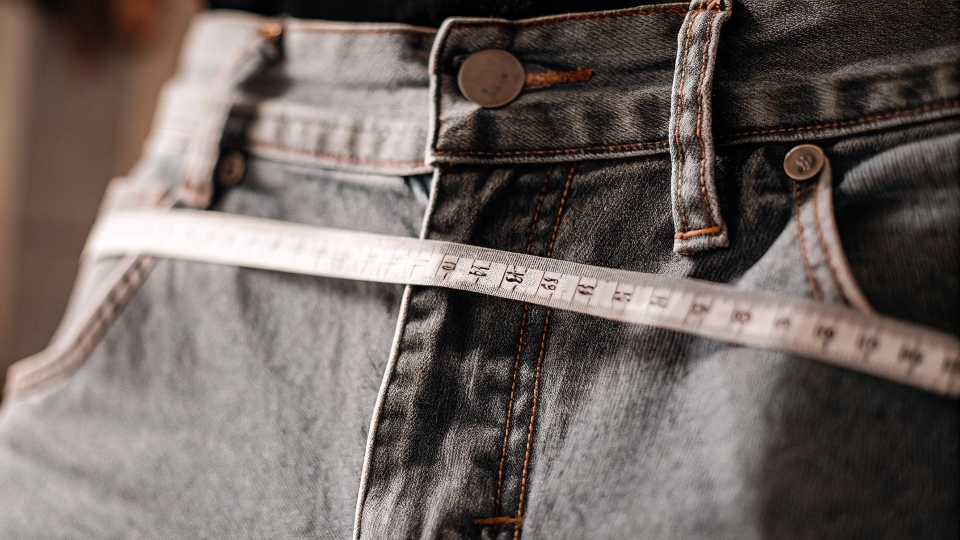You're shopping for jeans, and you see the size "32/301" on the tag. It seems straightforward, but a moment of doubt creeps in. Getting it wrong means a trip back to the store.
In the standard sizing format "32/30," the first number (32) represents the waist size2 in inches, and the second number (30) represents the inseam3, or leg length, in inches. This is the most common sizing system for men's pants.
After two decades running my denim factory, DiZNEW, I can tell you that these two numbers are the most basic and important instructions for creating a pair of jeans.
They are the fundamental blueprint. My friend Dean, a top denim designer in New York, builds his entire creative vision on this simple foundation.
While it seems simple, there's a lot of nuance behind those numbers that can make a huge difference in how your jeans actually fit. Let's decode the numbers so you can shop with total confidence.
Does 32/30 mean waist then leg length?
You see the two numbers separated by a slash and assume there's a standard order. But with so many brands doing their own thing, you need to be sure before you buy.
Yes, the "W/L" format, where "W" is waist and "L" is length, is the industry standard. So, a pair of jeans labeled 32/30 will always signify a 32-inch waist and a 30-inch inseam length.
This sizing system was a major innovation in menswear. It allows for a much more customized fit right off the rack, catering to men of different heights and builds.
Unlike women's jeans, which are often sold with a single size number (like 8, 10, 12) and a standard length, this two-number system gives you direct control over the two most critical fit points.
When my factory receives a "tech pack4," which is the detailed blueprint for a new jean design5, the waist and inseam measurements are the starting point. Every other measurement, from the thigh to the leg opening, is built around this W/L ratio.
This system creates a clear and universal language between the designer, the manufacturer, and you, the customer. It's a simple standard that makes finding a better-fitting pair of pants much, much easier.
Does size 32 jeans mean 32 inch waist?
You buy a pair of size 32 jeans, but when you measure the waistband at home, it's actually 33 or 34 inches. This makes you question if the numbers on the tag mean anything at all.
Ideally, yes, but in reality, no. A size 32 jean is designed to fit a person with a 32-inch waist, but the actual garment often measures larger. This common practice is known as "vanity sizing6."
Vanity sizing is one of the most confusing things for shoppers, but it's a constant in my world. Brands intentionally label their pants with a smaller size to make customers feel good.
In the factory, we don't follow a universal "32-inch" rule. We follow the brand's specific rule. I could have five different clients who all order a "Size 32" jean, and each one will have a different actual measurement in their tech pack.
The fit of the jean also plays a huge role. A "slim fit" size 32 will feel tighter than a "relaxed fit" size 32, even if the waistband measures the same, because of how it's cut through the hip and thigh.
The key takeaway is to not trust the number on the tag literally. It's a starting point, a name for a size, not always a precise measurement. This is why trying jeans on is always the best policy.
Example of "Size 32" Variation
| Brand Type | Size on Tag | Actual Waistband Measurement | Reason for Difference |
|---|---|---|---|
| Heritage Brand | 32 | 32.5 inches | True-to-size fit, minimal vanity sizing. |
| Mass-Market Brand | 32 | 33.5 inches | Uses vanity sizing to appeal to a wider audience. |
| Fashion Brand | 32 | 34 inches | Significant vanity sizing, often has a lower rise. |
Is 32 length regular or long?
You know your waist size, but leg length feels like a guess. You see options like 30, 32, and 34, and you're not sure which one is considered the standard or "regular" size.
A 32-inch inseam (length) is widely considered a "Regular" length, especially for men of average height, typically between 5'9" and 6'1". A 30 inseam is "Short," and a 34 is "Long."
The inseam is measured from the crotch seam down to the bottom of the leg hem. While there are general standards, the "right" length for you depends on two things: your actual leg measurement and your preferred style.
The guidelines are just a starting point. Style can completely change what length you choose. For a classic, clean look where the jeans just touch the top of your shoes (called a "clean break"), the standard height guidelines work well.
However, for modern streetwear styles that feature a "stacked" look, where the fabric bunches up around the ankle, you would need a much longer inseam. A designer like Dean might specify a 34" or even 36" inseam for a man who is only 5'10" to achieve this specific look.
So, think about how you want your jeans to fall before you choose your length. The best way to be sure is to measure the inseam on a pair of jeans you already own that has the perfect length for your style.
What does 30x32 mean?
Just when you get used to the "32/30" format, you see a pair labeled "30x32." This reversal makes you second-guess everything and worry you will end up with short, wide pants.
This is the same sizing system, just written in a different order. "30x32" still refers to waist and length. It simply means a 30-inch waist and a 32-inch inseam. The smaller number is almost always the waist.
While the W/L (waist/length) format is the most common, some brands, especially in the US, use the WxL (waist x length) format. It can be a little confusing at first, but the logic is the same.
It is exceptionally rare for a person's inseam measurement to be larger than their waist measurement, so you can safely assume the smaller number is the waist. For example, you will see a 30x32, but you will almost never see a 40x30.
This simple logic can help you decode the label no matter how it's written. The most important thing is to move past the format and just know your two personal numbers: your ideal waist size (considering vanity sizing) and your ideal inseam length (for your preferred style).
In my factory, it doesn't matter if a client writes 32/30 or 32x30 on the order; we have separate columns for "Waist" and "Inseam" on our technical sheets to avoid any confusion.
Conclusion
The numbers on your jeans tag are simple: the first is your waist, the second is your leg length. Understanding this W/L system is the first step to finding the perfect fit.
-
Understanding the 32/30 size can help you choose the right fit and avoid sizing mistakes. ↩
-
Learn how waist size is measured to ensure you select jeans that fit comfortably. ↩
-
Discover the importance of inseam measurement for achieving the perfect length in jeans. ↩
-
Explore what a tech pack is and how it guides the production of jeans. ↩
-
Discover the elements that go into jean design to appreciate the craftsmanship behind your jeans. ↩
-
Explore vanity sizing to understand why jeans may not fit as expected based on size labels. ↩











